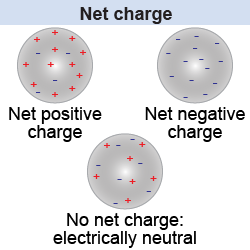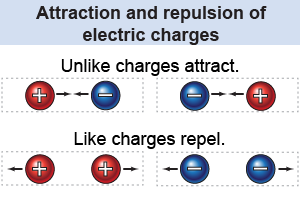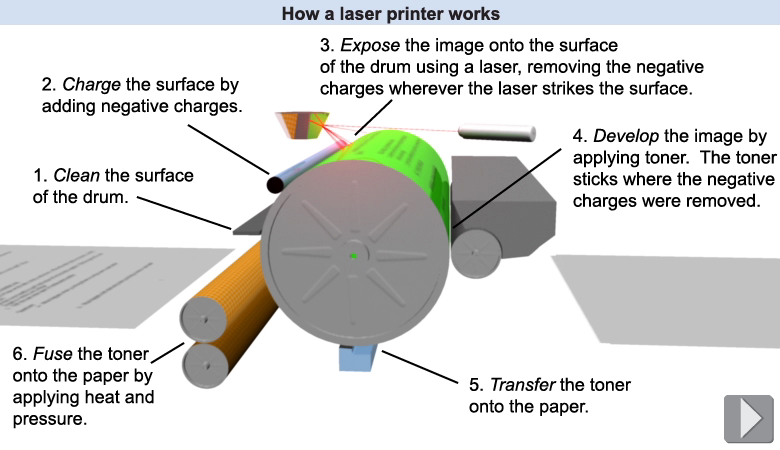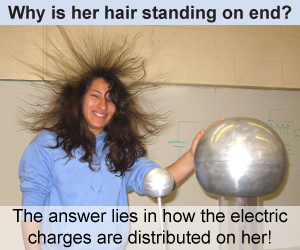|
Just as there are two different magnetic poles in magnetism, there are two different kinds of electric charge: positive and negative. As you might expect, diagrams often use the plus sign (+) and negative sign (−) to tell them apart. 
|
 Your body is full of electric charges: not just a few, but many—around 1029! You are not a walking lightning factory because every positive charge in every atom of your body is exactly balanced by a negative charge in the same atom. At macroscopic distances the electrical effects of positive and negative charges inside atoms cancel each other out. Your body is electrically neutral, which means that it has no excess of either positive or negative charge. In physics terms, your body has no net charge. Most objects around us are similarly electrically neutral. If this weren’t the case, lightning would be everywhere, all the time!
Your body is full of electric charges: not just a few, but many—around 1029! You are not a walking lightning factory because every positive charge in every atom of your body is exactly balanced by a negative charge in the same atom. At macroscopic distances the electrical effects of positive and negative charges inside atoms cancel each other out. Your body is electrically neutral, which means that it has no excess of either positive or negative charge. In physics terms, your body has no net charge. Most objects around us are similarly electrically neutral. If this weren’t the case, lightning would be everywhere, all the time! 
|
The forces between positive and negative charge can be attractive or repulsive, similar to the forces between north and south magnetic poles. - The electric force between electric charges is enormously strong.
- The electric force is a universal force that exists between any two objects that contain net positive or negative charge.
- Electric forces hold atoms and molecules together by providing half of the underlying “glue” that maintains the structure of matter.
- Electric forces are so strong that, outside of atoms, positive and negative charges are rarely separated, so the forces are almost never directly evident!

|
 Similar to magnetic poles, opposite electric charges attract while similar electric charges repel. A positive charge repels other positive charges but attracts negative charges. A negative charge repels other negative charges but attracts positive charges. A neutral object, with zero charge, feels no electric force from either positive or negative charge.
Similar to magnetic poles, opposite electric charges attract while similar electric charges repel. A positive charge repels other positive charges but attracts negative charges. A negative charge repels other negative charges but attracts positive charges. A neutral object, with zero charge, feels no electric force from either positive or negative charge. 
 |
 The laser printer is a commonly available device that allows you to print pages in black and white or color. It is based on the physics of electric charge, photoconductivity, and the laser.
The laser printer is a commonly available device that allows you to print pages in black and white or color. It is based on the physics of electric charge, photoconductivity, and the laser. - Clean: Leftover, excess toner and residual charges from previous images are removed to prepare the surface of the drum.
- Charge: The surface of the drum is coated with negative electric charges.
- Expose: The laser shines onto the surface of the drum to “write” the page you want to print. The laser is fixed in position while a rapidly moving or “scanning” mirror reflects the laser’s light onto different parts of the drum. The computer’s signals turn the laser light on and off to represent black and white portions of the page, respectively. Wherever the laser light strikes the drum, the negative charge is removed from the surface through a process called photoconductivity, thereby leaving a negative image of your page on the drum.
- Develop: Negatively charged toner is applied to the surface of the drum. The toner sticks wherever there is no negative electric charge, and it is repelled from locations that still contain negative electric charge.
- Transfer: The toner is transferred onto the paper upon contact. The transfer may be made more efficient by using a positively charged roller to attract the toner onto the paper.
- Fuse: Heat and pressure are applied to the paper to bond the toner onto the paper.

|
 The student’s hair in the diagram is springing away from her head. Why? The answer is that the Van de Graaff generator she is touching has charged her body (and hair) uniformly negative. Like charges repel, so every negative charge repels every other negative charge as far as possible. The charges on the student’s head spread outward from each other into her hair. This student has light, fine hair and the charge on each strand of hair repels each neighboring strand to create the truly electrified hair style you see in the picture.
The student’s hair in the diagram is springing away from her head. Why? The answer is that the Van de Graaff generator she is touching has charged her body (and hair) uniformly negative. Like charges repel, so every negative charge repels every other negative charge as far as possible. The charges on the student’s head spread outward from each other into her hair. This student has light, fine hair and the charge on each strand of hair repels each neighboring strand to create the truly electrified hair style you see in the picture. 
 |
The same principle applies to the Van de Graaff generator on page 519. The positive charges repel each other, so they distribute themselves evenly around the metal sphere. 
|
If, in general, bodies have the same number of positive and negative charges, then how is there ever any net electrostatic force?
 |
Sometimes, charges can be transferred, for example through friction, and then there is a net charge and a force. 
|
| |
|

